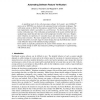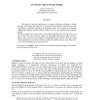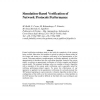148
Voted
SBMF
2010
Springer
14 years 7 months ago
2010
Springer
Designers of concurrent and distributed algorithms usually express them using pseudo-code. In contrast, most verification techniques are based on more mathematically-oriented forma...
124
click to vote
PERCOM
2010
ACM
14 years 10 months ago
2010
ACM
In autonomic networks, the self-configuration of network entities is one of the most desirable properties. In this paper, we show how formal verification techniques can verify the ...
108
Voted
FMSD
2000
15 years 8 hour ago
2000
We review a number of formal verification techniques supported by STeP, the Stanford Temporal Prover, describing how the tool can be used to verify properties of several versions o...
105
click to vote
BELL
2000
15 years 1 days ago
2000
A significant part of the call processing software for Lucent's new PathStar access server [FSW98] was checked with automated formal verification techniques. The verification...
130
Voted
TDSC
2008
15 years 3 days ago
2008
Specifying and managing access control policies is a challenging problem. We propose to develop formal verification techniques for access control policies to improve the current s...
116
Voted
ENTCS
2006
15 years 6 days ago
2006
The traditional approach to validate analog circuits is to utilize extensive SPICElevel simulations. The main challenge of this approach is knowing when all important corner cases...
96
Voted
FORTE
1994
15 years 1 months ago
1994
The record of successful applications of formal verification techniques is slowly growing. Our ultimate aim, however, is not to perform small pilot projects that show that verific...
110
Voted
ISICT
2003
15 years 1 months ago
2003
: Cryptographic protocols are used to achieve secure communication over insecure networks. Weaknesses in such protocols are hard to identify, as they can be the result of subtle de...
CHARME
1997
Springer
15 years 3 months ago
1997
Springer
Formal verification techniques need to deal with the complexity of the systems rified. Most often, this problem is solved by taking an abstract model of the system and aiming at a...
106
Voted
DATE
2004
IEEE
15 years 3 months ago
2004
IEEE
Formal verification techniques have been playing an important role in pre-silicon validation processes. One of the most important points considered in performing formal verificati...



